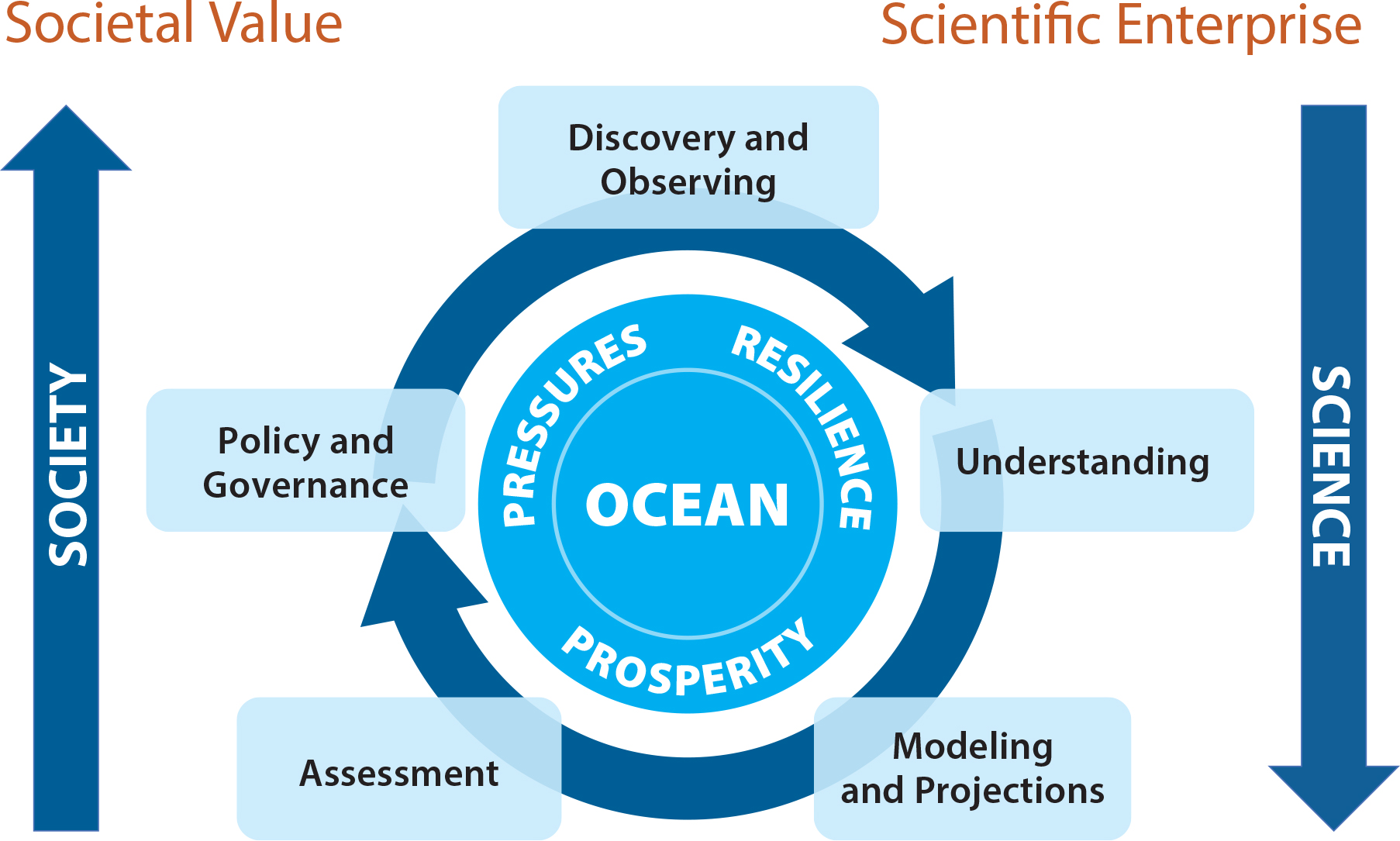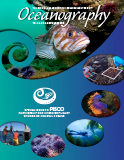Full Text
Ocean science is producing data, understanding, and information—but are we maximizing their uptake and use across all ocean-related communities? Are we making the most of the impact ocean knowledge can have on society?
In thinking about the social contract between science and society, I found it helpful to draw a diagram that I call the “ocean value cycle” (Figure 1). It connects the flow of information and questions among five activities. Activities related to ocean discovery and observing, improved ocean system understanding, and the generation of predictions and scenario development are often the focus of research groups located at ocean science laboratories or in university departments. Ocean assessment benefits from the information generated by the research enterprise and can inform societal actors in the policy, governmental, or private sectors. However, very often significant uncertainties or impediments to action raise new science questions that motivate new discovery or improved observation, deeper system understanding, or improved predictions. The value cycle never ends.
What are the key elements of my proposed ocean value cycle?
 |
Figure 1. The ocean value cycle. > High res figure |
1. Ocean Discovery and Observing
The vast volume of the ocean and its complex coastlines may never be fully observed nor adequately understood. The deep sea in particular is an exciting frontier. Many discoveries in this realm are being made today, and we can expect more in the years to come. Sometimes internationally coordinated teams can reveal new areas of our planet, new phenomena of profound importance, or new organisms and substances. Sustained and systematic ocean observing can document ocean changes, provide critical information to initialize ocean system models, and provide essential data that will improve ocean understanding.
2. Ocean Understanding
The ocean is a very complex and connected global system. For centuries, ocean scientists have been trying to understand ocean dynamics, chemistry, biology, and ecosystems, as well as the geology of the seafloor and meteorology above the ocean. Internationally, several project teams are conducting innovative and coordinated research to improve ocean understanding and the interactions among the various systems.
3. Ocean Modeling and Projections
Ocean system models often focus on specific challenges such as the physical climate, ocean biogeochemistry, the sediment-ocean interface, coastal regions, or fisheries. Near-real-time ocean prediction to inform safe navigation, warn coastal communities of imminent threats, or enable seasonal climate forecasting are well-established activities in many parts of the world. Population increase, economic wealth, and an increasing human footprint on the environment will cause more profound changes in the future, raising the question: How will the ocean change in the Anthropocene? What effects will climate change, increasing fishing, coastal development, and growing levels of environmental pollution have on the ocean in the next 20, 50, 100, and 200 years? These future ocean scenarios are also slowly emerging.
4. Ocean Assessment
Ocean observation and ocean system modeling lead to new scientific understanding. In order for the societal system to react, there is a need for issue-specific ocean assessment. The ocean’s role in the climate system is part of the well-established climate assessment, notably in work of the IPCC (Intergovernmental Panel on Climate Change), while changes in marine biodiversity are increasingly covered by the IPBES (Intergovernmental Science-Policy Platform on Biodiversity and Ecosystem Services) process. At the UN level, the First World Ocean Assessment was released in 2016. However, no assessment exists today that covers all aspects of the ocean domain, a gap that should be closed in order to improve ocean governance to support the sustainable development agenda.
5. Ocean Policy and Governance
The legal regime of the ocean and coastal zone is complex. And the connectivity of the world ocean though its global circulation pattern means that ocean governance will yield the best outcome when it is regionally or globally coherent. Authority, transparency, and the ability to encourage good behavior are particular challenging in the ocean domain. Equitable access, burden, and benefit sharing as well as transnational cooperation warrant innovative approaches to ocean governance. New ocean policies or governance options often require deeper insights and more precise ocean information. This need can be addressed by an improved and fit-for-purpose ocean observing system, better ocean understanding, and more accurate predictions or scenarios of future ocean and climate change.
In some form, the value chain described above is implemented in most parts of the world. However, the information flow across the interfaces is not always optimal. Barriers between different communities, limited data flows and data system connectivity, and use restriction can lead to disconnects in the value chain. Who is to blame? Society for not articulating clearly what it wants? The science enterprise that only wants to answer its own questions? Language and data flow barriers? I see many opportunities to improve how we act as an ocean sciences community. My wish is that we all be more aware of those who can use our information and knowledge and reach out to them to discuss how to bridge gaps. We also could be more aware of the questions that others might have that are applicable to our field of expertise and engage in broader discussions about future priorities.
Finally, a fully connected ocean value cycle could enable a whole range of innovative and new ocean solutions. They could inform stakeholders and decision-makers about options in the context of sustainable development of the marine sphere. Areas such as sustainable fisheries, least destructive exploration, renewable energy, effective and equitable marine spatial planning, marine carbon management, transparent governance, and sustainable tourism are just some examples of ocean solutions for a more sustainable world. The connection between ocean science and sustainable development will be further advanced during the upcoming Decade of Ocean Science for Sustainable Development (2021–2030). More information about the Ocean Decade can be found on its website (https://oceandecade.org) and in Visbeck (2018).
Ocean science knowledge can provide societal value at local, regional, and global scales. It can provide answers to questions about future increases in pressures on the ocean system. It can also inform disaster risk reduction actions, improve resilience of the ocean ecosystem to shocks, and safeguard coastal communities from ocean-related threats. Finally, ocean science knowledge can be used to increase human prosperity today and for future generations if ocean resources are used in a sustainable and equitable way. The Oceanography Society, together with its international partners and programs, can make a big difference to the generation of ocean value by doubling our efforts to communicate with our friends and partners in areas that are related to ocean science as well as with other societal actors.
– Martin Visbeck, TOS President

